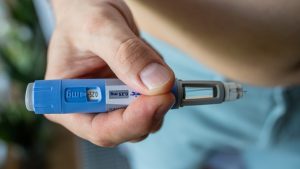Articles / Choosing, changing and tweaking antidepressants

Unfortunately we do not know what is pathologically wrong in depression. We have lots of nice theories but we do not know, and if we do not know what is wrong, then we do not know how the antidepressants work.
What we do know is that there was a meta-analysis of double-blind RCTs published in The Lancet in 2018, in which the trials were analysed in quite a ruthless statistically analytical way and the authors concluded that all our available antidepressants are better than placebo.
So that is the thing to know. We do not know how they work but we do know that they do work.
What the research says is that any antidepressant will have, in very broad terms, very good effect in one third of people, a limited effect in one third of people, and no effect in one third of people. That means that for two thirds of people, we have to change or supplement the antidepressant.
Textbooks say it takes four to six weeks for antidepressants to work, but that is not quite correct. It is four to six weeks for them to get to their maximum effect, but within two weeks or three weeks you will start to see some improvement.
If there is no benefit within the first two or three weeks, as in flashes of improvement or some lightening of symptoms, it is 80% to 90% certain that the patient will never respond to that antidepressant, no matter what dose you give them or for how long, and it is time to move on.
But when there is some response, that’s when you would push the dose up every week or two until you reach the manufacturer’s maximum recommended dose. Or remission, as indicated by return of the patient’s pre-morbid ability to remember what they read.
There are a number of things that you can do.
If the patient has moderate or severe anxiety, give them something extra for their anxiety. This may be a short course of benzodiazepines because in my very strong opinion anxiety fuels depression, and phrased differently, antidepressants cannot work effectively in the presence of severe anxiety.
Apart from a short course of benzos such as low dose temazepam or diazepam, consider adding an atypical antipsychotic such as quetiapine, aripiprazole or brexpiprazole, noting potential side effects such as lethargy for quetiapine and weight gain for brexpiprazole (and for aripiprazole, to a lesser extent), and the fact that atypical antipsychotics are not PBS-listed as anxiety treatments.
Any of the standard hypnotics are effective as antianxiety agents, so patients who get sudden bursts of anxiety during the day or get panic attacks, may well benefit from taking half a temazepam, and the same applies to a drug such as zopiclone (Imovane) and zolpidem tartrate (Stilnox).
Higher doses put people to sleep, lower doses reduce their anxiety.
For example you can use diazepam (Valium) for anxiety during the day and higher dose diazepam for sleep for people who have insomnia.
Another very useful technique which the literature says works in about two thirds of people is to add in pramipexole.
This Parkinson’s treatment is a dopamine agonist, but taken at higher doses it can work as a supplement to an antidepressant.
The benefit of pramipexole is that it works pretty quickly, quite often within one week or two weeks of adding it to existing antidepressants people notice a significant improvement.
The dose we need in treating depression is about 2-3 mg at night, so it is not the low doses in Parkinson’s disease; it is the higher 1 mg tablets. The side-effects of pramipexole are either nausea or disinhibition such as increased spending or inappropriate behaviour, so you give people a low dose and if nothing happens for the first few days in terms of side-effects, you go up pretty quickly.
And the benefit of pramipexole is that it works pretty quickly, quite often within one week or two weeks of adding it to existing antidepressants people notice a significant improvement.
There are four antidepressants that can be fairly safely added to an SSRI:
The concern with the older TCAs is their more extensive side effect profile when compared to modern antidepressants, and the risk of fatality in overdose. However, some TCAs have non-mood related benefits. For example low dose amitriptyline can be used as a prophylaxis against migraine, or in treatment of chronic pain. Clomipramine has particular effect in relieving symptoms of obsessive compulsive disorder. Mianserin does not have anticholinergic or cardiac problems, but weight gain is common.
There are six SSRIs which DO NOT interfere with the metabolism of TCAs, and therefore in theory would not increase their bioavailability if combined:
In higher doses of TCAs, a regular ECG to check for QTc prolongation is indicated, and a serum trough level of imipramine or amitriptyline can also help guide treatment.
TCAs should not be used for the suicidal patient, as they can be fatal in overdose.
The standard approach to an antidepressant is to give half a tablet for the first two days to avoid onset agitation, then give one tablet and wait about two weeks and if really nothing is happening then you may increase the dose— but it is looking grim at that stage. That approach of waiting two weeks or three weeks predicts with about 80% accuracy whether or not people will have any chance of responding to that antidepressant. The clinical response is far more significant, and rather than waiting for a pharmacogenomic test to come back – it is easier to actually prescribe a medication and start the ball rolling.
I have mentioned the antidepressants that you can safely mix with each other, and the real question is: should you give people two SSRIs? In the vast majority of cases, it is not a problem.
Remember that in the rare cases where people do start to get the serotonin syndrome, it is a spectrum of illness ranging from the vast majority of people with mild symptoms to a few at the other end of the spectrum who have serious if not life-threatening symptoms.
However, death from serotonin syndrome is almost unheard of. In Australia death from suicide is almost 10 a day and as I say attempted suicide is probably 200. So all things are relative. And some psychiatrists are continuously mixing SSRIs together.
If people do start to get the serotonin syndrome, typically they may start perspiring quite profusely and their muscles may start quivering, they may develop hyperreflexia or they may just feel generally feel pretty unwell.
There is a very simple antidote for most cases of serotonin syndrome, especially when it is mild and that is over-the-counter cyproheptadine (Periactin), which is used as an anti-allergy medication but it is actually an anti-serotonin drug. They come as 4 mg tablets and the treatment is to give a patient three tablets in one hit, in one stat dose, you give them three 4 mg tablets. They may get a bit sedated, but it should stop the serotonin syndrome if that is what is happening.
Informed consent is important. It is a good idea to make a note that you have explained this is unusual treatment and do they want to retain the benefits of the first antidepressant or do they want to do what has been traditional practice, which is stop the first one, which may take some time to avoid withdrawal reactions, then wait a gap for a washout, then start the next one and hope to God that the next one has some impact not just zero impact.
The vast majority of people will say that depression is not only painful but ‘it risks my job, my marriage and indeed my life so I want to take the risk of adding in a second antidepressant’. The sicker the patient is, the more I compare it with an Intensive Care Unit where no one is going to say look we do not have double-blind placebo-controlled trials saying we will give you three different antihypertensives or three different antibiotics or three different anti-asthma drugs, they just pour everything in when things are getting desperate.

Menopausal Hormone Therapy - What Dose of Estrogen is Best?

Cardiovascular Benefits of GLP1s – New Evidence

Oral Contraceptive Pill in Teens

RSV and the Heart


Modified but kept in place
Eliminated entirely without replacement
Maintained as is
Completely replaced with an alternative system
Listen to expert interviews.
Click to open in a new tab
Browse the latest articles from Healthed.
Once you confirm you’ve read this article you can complete a Patient Case Review to earn 0.5 hours CPD in the Reviewing Performance (RP) category.
Select ‘Confirm & learn‘ when you have read this article in its entirety and you will be taken to begin your Patient Case Review.
Menopause and MHT
Multiple sclerosis vs antibody disease
Using SGLT2 to reduce cardiovascular death in T2D
Peripheral arterial disease
